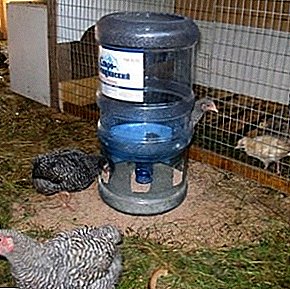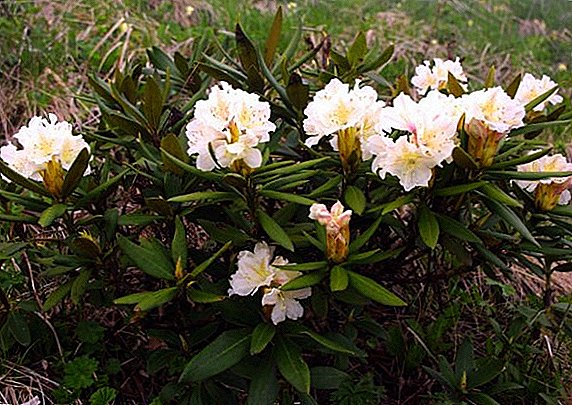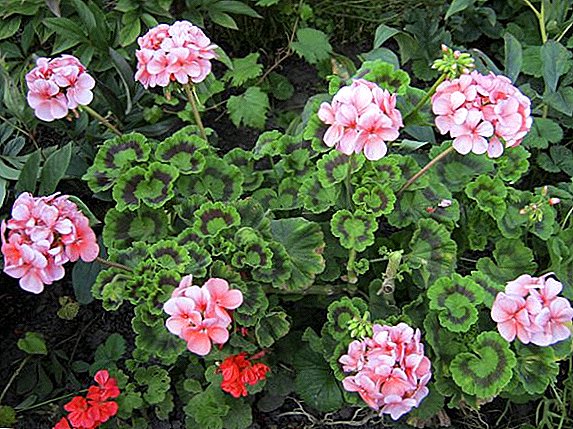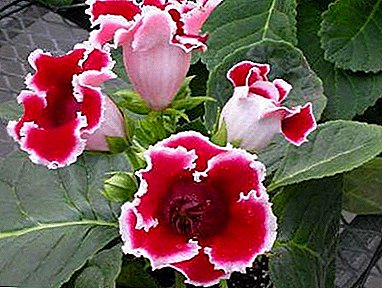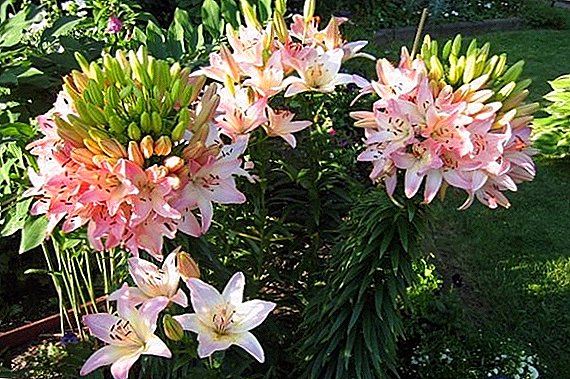
Spectacular lilies are able to decorate any area. Varieties and colors - a great many, literally for every taste. But many are confused by the "firm" tart smell emanating from these plants. Against this background, lily "Marlene" stands out, which does not distribute its "amber", so it makes sense to consider such a flower in more detail.
Variety description
This is a hybrid variety that has resulted from the "crossing" of Asian lilies with multicolor longiflorums. As a result, plants were obtained that rooted easily and bloomed quite early, moreover, they tolerate cold quite well. 
On the tall (0.9-1 m) stalks of a pale green color, the oblong leaves are pointed alternately, pointed at the edges. Their sizes are noticeable - a length of 11-13 cm is considered standard (whereas the width is much more modest and rarely exceeds 1.5 cm). On one peduncle you can count at least 15-20 buds.
All this green mass keeps the rhizome in the form of bulbs covered with scales.
In late June - early July, it is time to bloom: large flowers appear. Typically, their diameter reaches 15 cm, but on light soils, real giants of 17–19 cm can appear. The tips have a pale pink color, which, as it approaches the center, is replaced by an almost white “edge”.
Important! Transparent bulbs in bright packages look attractive. But a tightly closed pack will not give the opportunity to examine the planting material for damage. So do not rush to buy a "cat in the bag."A description of such a flower as the Marlena lily will be incomplete without mentioning its brightest feature. It is about the multicolor, which provided the plant popularity among gardeners.
This species can "shoot" dozens of flowers, but you should not expect it at once - mass flowering is observed for 2-3 years. The reason for this phenomenon is well known to experienced flower growers.
This is a process known as fasciation (splicing of several young peduncles into one stem with numerous flower buds). But here there is one nuance that many people forget about - “marlene” is really predisposed to such mutations, although not every seedling will give such a violent color. 
Speaking in scientific language - fasciation inherent in representatives of this variety is not an absolutely fixed sign. So do not trust the sellers, who solemnly assure that the onion sold by the middle of summer "will give birth" to almost a hundred flowers. This is possible, but no one can give a full guarantee.
You will also be interested to know the classification of daylily varieties: how daylilies are divided according to the height of peduncles, according to the shape and size of the flower, according to the types of vegetation, according to the timing of flowering, according to the flowering time.
Features of landing in an open ground
For the successful cultivation of decorative lilies have to find a suitable place. Landing on the first "latka" may not give the expected result, so let's start with the requirements for the ground.
Selection of soil and plot
The optimum landing ground will be a loosened fertile soil with good drainage. High bedding of groundwater is undesirable. 
The bulb can be taken on loam, but then you will need feeding, which will be discussed a little later.
Did you know? Lily is often found on various coats of arms. This stylized design element is considered one of the most popular "stamped" details (along with eagles, lions and crosses).As for the place, then a corner with pronounced penumbra is best. Regular hit of direct rays makes the stems and buds sluggish, while the abundant shade inhibits growth. The strength of the wind is also taken into account - powerful air flows can break the fragile bud.
Consider that landing is carried out in the middle of April - the first decade of May.
Watering
On the site provide abundant and regular watering.
It begins right from the moment of disembarkation, when about 10 liters of water are poured into the prepared well. After letting it sink in, you can take onions and plant them.
After the seed is dusted and tamped with soil, the surface of the hole is moistened again. By the main irrigation start in 4-6 days (depending on how quickly the earth dries out).
Most lilies prefer penumbra, so they can be planted next to junipers, cypresses, thuja, ferns.
Top dressing
If you have to deal with "heavy" soil, be sure to make a preliminary feeding. Most often, a rotted mullein is taken (5-10 kg / sq. M with an increase in dose for weak soil). As an option - complex mineral compositions in the amount of 60-100 g per "square" area.
But fresh manure is not suitable for such purposes - such a powerful "organic" in large quantities just "burn out" the onion. 
After such preparation proceed directly to landing. This procedure is quite simple and familiar to all owners of villas or gardens:
- The bulbs are disinfected by karbofos.
- Dig holes. "Young" lay at a depth of 10 cm, and large bulbs twice as deep. Remember that they will take roots, so you have to go deeper into twice the level.
- Clean sand is laid on the bottom (a layer of 1 cm is enough).
- Then the "seat" is moistened (about a bucket of water).
- Bulbs planted spine down, sprinkled with earth and tamped.
- The final chord will be abundant (up to 15 liters) watering with further mulching. The hole is covered with a layer of straw that will hold moisture.
Important! Land for planting should not be located near the slope - the accumulation of storm water will significantly complicate the cultivation of lilies. In the rainy season, the rhizome may even die.
Plant Care
Planting lilies varieties "Marlene", as you can see, is not difficult, but for the flower to take root in the open field, you will need more and stable care. 
Watering
The main condition is regularity. In hot summer, the plant is constantly moistened by pouring a bucket of water every 2-3 days under the plant. It is important not to overdo it, otherwise the rhizome will become too wet and become vulnerable to rot.
The "golden rule" of all summer residents - the land should not dry out. As soon as you notice that the soil begins to be taken in a ball, immediately water the flower. Of course, we should not allow cracks to appear in the fertile layer - in such cases, the bulb risks drying out.
During the flowering period, the intensity of watering is somewhat reduced. After it, the interval between humidifications is gradually increased so as to stop them altogether by mid-autumn.
Lilies look very nice against the background of low plants: iberis, alissum, marigolds, garden carnation, geyhery. Between the bushes of lilies, you can plant asters, delphiniums, chamomile or gladioli.
Loosening
When the planting mulch is removed, the holes are loosened after each watering. This is necessary - if you miss the moment, the rhizome will suffocate in the compacted soil.
Did you know? The Spaniards with the Italians lily is considered a living symbol of the Virgin Mary. Not a single large Catholic holiday is complete without large bouquets, in which they try to include as many varieties as possible.Ideally, this manipulation is performed the day after abundant watering. Moisture is absorbed at this point, and the trident itself or a little glanders will not slide over the mud.
By the way, about the tool. Choosing the "props" for loosening or weeding, keep in your mind the depth of the onion. For a not very deep material, the trident will be safe. More "sweeping" glanders with a long handle and a wide blade with the wrong backswing can catch seed. It is best used for working with rhizomes that lie deeper than 15 cm.
In addition to loosening, you also need regular cleaning of weeds. Do not give them discounts - even a few small blades of grass can be a problem for weak plants. It is best to clean them after watering - “wet” you can uproot even small weeds.

Top dressing
Seasonal cycle "recharge" of this flower provides for three main fertilizer application:
- The first feeding is done during the emergence of shoots. The main "dish" - nitrogen-containing compounds. They should be complex (the odds in the direction of ammonia compounds will work only for green mass).
- The formation of buds gives the signal to make the same complex "mineral water" or organic compounds. Usually taken liquid mullein mixed with water in a ratio of 1/10. Good results are obtained by using humus and wood ash (100 g / sq. M).
- The emphasis on potash-phosphorus mixtures is done “under the curtain” of flowering, when the lily needs to be prepared for dropping the flowers, at the same time keeping its growth rate.
Important! Before planting the roots can be "pickled" insecticidal compositions. Among them - BN-58, "Chlorofos" and "Phosphamide" in a concentration of 0.1%.After flowering, fertilizers are no longer applied.
Transfer
At 4-5 years after planting, you can see that the stem is no longer growing, and the buds have become smaller. These signs suggest - the mother bulb is depleted or too tightly surrounded by subsidiary "bubki". Only one way out - transfer to a new place.
Its algorithm will be:
- Dug in the autumn bulbs cleaned from the ground and washed.
- Then they should be kept in a weak solution of permanganate (about half an hour).
- After allowing the material to dry, it is placed in a dense layer of sawdust or moss.
- The container with such a “tab” is stored in a dark place at a temperature not higher than 20 ° C.
Breeding
Its scheme is traditional and simple - it's familiar to everyone. rhizome division "on the kids." In the course of its development, the lily of the popular variety "Marlene" does not release so many daughter bulbs, so many people use this technique closer to the end of September to ensure the production of new plants for the next year.
Did you know? Norse mythology also did not pass this flower. In many images, the god of thunder, Thor, holds in his left hand a scepter surmounted by a lily.Digging up the root in the fall, you will see that such "growths" disappear by themselves, which facilitates the task. Even if they are not separated immediately - do not worry, with any further work cope:
- Gently separate the kids with a knife.
- Be sure to clean them from the ground and let dry.
- Rate condition. If stains are visible on the scales, immediately remove the infected cover - this is a beneficial environment for fungal diseases.
- Then remove the dead roots. Small leave, keeping a maximum of 15 cm.
- The material thus collected is pickled with potassium permanganate and dried again.
- At the very end, the bulbs are sorted by size. The smallest are trying to immediately bring to the size of the adult "bubki". To do this, they are grown on a separate bed in a greenhouse or in pots. If there is no time for this, they can simply be “wrapped” in sawdust and left for the winter in a cool dark place.

In the first year after planting, the “young” will not bloom, but over the season the plant will thoroughly strengthen.
Important! Be extremely careful - even strong-looking shoots are very easy to break.
Another effective, but not very popular method - reproduction from scales. Looking closely, you can make sure that this is also a very simple way:
- In early April, the adult bulb is taken. Several scales are removed from it. At the same time, the “donor” is not thrown away, but put in a pot with further transplantation into the soil.
- The flakes are mixed with sawdust (1/4), but before that both “ingredients” of the mixture are treated in a light solution of permanganate (up to 0.3 g per 1 l of water) and dried a little.
- The entire workpiece is placed in a bag. It is closed and put in a corner with a temperature of 18-20 ° C. As required, the soil is sprayed.
- After 12-14 days, the scales will "beat off" the onions with fine roots. Letting the children grow up to 1 cm, they are carefully transferred to a small cassette or cardboard box filled with the substrate (about 5 cm).
- All this time they are watered, and the earth is loosened with a stick. The bulb can come to the surface - it is powdered.
- By mid-June, these seedlings can be “relocated” to an open area.

Preparing Marlene Lilies for Winter
In the autumn, when watering is already stopped, the stems turn sharply yellow. To tear off the withering processes do not hasten - the exchange of substances between the peduncle and the roots continues until the stem is completely dry. And only after that it is cut off.
After such a "dismantling" it would be nice to cover the remaining ground part with a film, making a small hole in it for ventilation. This has its reason - under the root will not accumulate moisture, which when frost can destroy it.
Did you know? In the culture of ancient Egypt, the image of the lily did not have a constant interpretation. The flower could act simultaneously as a symbol of purity and transient time, hope and freedom.With the onset of cold weather protective film is removed - "Marlene" endure cold. To help them with this, the hole is covered with a thick (at least 10 cm) layer of mulch. As a cover fit foliage, rotted pus or sawdust. But the best of all is the warmth of the spruce branches laid out of coniferous branches.
Diseases and pests
Unfortunately, no florist is insured against their appearance. Horticulture in this regard is a little more difficult - the proximity of lilies with vegetable plantations increases the risk of infection.
But do not despair - in time to find disease, you can quickly eliminate its cause. Most often flowers suffer from:
- Gray rot. In cool weather, brown specks may appear on the leaves and the lower half of the stems. So that they do not switch to the buds, they use fungicides like "Homa" (40 g per 10 l of water). If necessary, the treatment is repeated after a week. It is better not to take the 1% Bordeaux liquid popular in our area - the slightest mistake with the dose will “finish off” the bud.
- Rust. Affected leaves are removed, and the plant itself is treated with Fitosporin (1.5 g of powder is added to 1 l of water).
- Fusarium (bulbous rot). It is unrealistic to cure the affected buba on the open field, therefore, even before planting, it is treated with the preparation “Fundazol” (for 2 hours it is placed in 10 liters of water with the addition of 2 g of the composition).
Important! Carefully read the instructions - the dosage for "dacha" and "pot" flowers of the same species may differ significantly.Do not forget about pests, the main of which remain various ticks. They are eliminated by strong insecticides. Among them, “Fitoverm” is distinguished - ampoules in 4 ml are enough for 1 liter of water. 2-3 repeated “approaches” are allowed with an interval of 8-9 days. Not bad and Actellic: 2 ml for 2 l of water - and the problem is solved (gentle spraying one lily is enough).

The raids of the lily beetles, wireworms and the bearfish will stop after spraying with Fufanon. It is sold in ampoules of 2 and 6.5 mg. This amount is enough for a mixture of 1.5 and 5 liters of water, respectively. In case of severe injury, repeated treatment is allowed.
Now you know what makes the Marlena variety lily interesting and how to grow it in the country. We hope that after a while you will still see the treasured hundred flowers on the planted plants. Let every day be bright!



